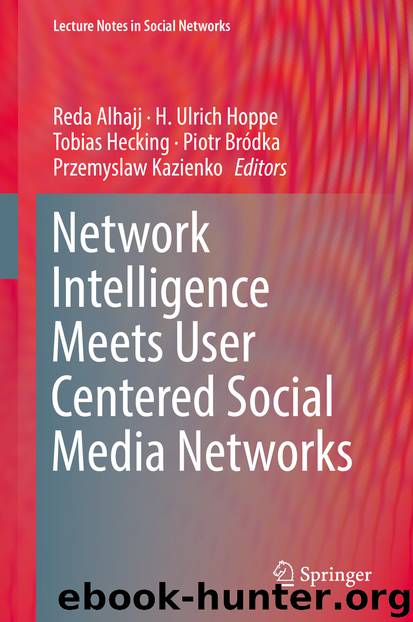Network Intelligence Meets User Centered Social Media Networks by Reda Alhajj & H. Ulrich Hoppe & Tobias Hecking & Piotr Bródka & Przemyslaw Kazienko

Author:Reda Alhajj & H. Ulrich Hoppe & Tobias Hecking & Piotr Bródka & Przemyslaw Kazienko
Language: eng
Format: epub
ISBN: 9783319903125
Publisher: Springer International Publishing
2 Literature Review
In recent years, there has been considerable research in the structure of real-world networks, and in modeling these networks as the results of several random procedures. Most of the graph models try to fit graph properties such as node degree distribution, clustering coefficient, average path length, diameter, etc.
In [13, 15, 30], different random graph models have been surveyed such as: classic random graph models [4, 6, 23], small-world models [29], and preferential attachment models [1]. Sala et al. [21] have classified those graph models into three categories. Firstly, feature-driven models which focus on generating synthetic graphs mimicking the statistical properties of real-world graphs such as power-law degree distributions and dynamic changes in network density over long periods. Models included in this category are the Forest Fire [9] and the Barabasi-Albert [1] models. Secondly, intent-driven models try to imitate the real-world processes of network generation. Examples are Random Walk and Nearest Neighbor models [27]. As the third category, structure-driven models try to generate synthetic graphs with the same structural restrictions as real-world graphs, e.g. Kronecker [8] and dK-graph [10] models.
In social networks research, due to the lack of empirical datasets for several reasons, several research led to graph models generation to produce synthetic graphs that can be replaced by real-world graphs to conduct the social networks research on them. Barrett et al. [2] introduced a model to generate synthetic contact-based graphs imitating urban and rural regions in the US (structure-driven models). They have used several real-world datasets and social theories to produce the links in the synthetic graphs. Sala et al. [21] tried to calibrate different random graph models to imitate real friendship graphs in Facebook. They have studied six different graph models to figure out which a proper model can be used to represent the real friendship-based graphs that have been introduced from Facebook.
Our work is related to the research presented in [21] in the sense that we aim to calibrate the different graph models to generate synthetic graphs that can represent real retweet-based graphs. Through graph models calibration, we introduce a new extended graph model that has highly accurate representation of the real retweet-based graphs compared to other proposed graph models. As well as, we have used the statistical similarity metrics (as in [21]) to evaluate the accuracy of each model in our study. In this paper, we have calibrated just the feature-driven models because of the following reasons: The structure-driven models acquire very high costs in memory or computation. Unlike other graph models that require creation parameters, this graph models have no such parameters. They require a set of design constraints (required degree distribution, clustering coefficient, etc.), then they try through some algorithms to generate synthetic graphs that match those constraints. Thus, those models are useful, but graph generation process using such models becomes costly for large graphs as in our situation.
Download
This site does not store any files on its server. We only index and link to content provided by other sites. Please contact the content providers to delete copyright contents if any and email us, we'll remove relevant links or contents immediately.
Rich Dad Poor Dad by Robert T. Kiyosaki(6317)
Pioneering Portfolio Management by David F. Swensen(6168)
How To Win Friends and Influence People by Dale Carnegie(4404)
The Money Culture by Michael Lewis(4026)
The Dhandho Investor by Mohnish Pabrai(3635)
The Wisdom of Finance by Mihir Desai(3606)
Liar's Poker by Michael Lewis(3322)
Fooled by Randomness: The Hidden Role of Chance in Life and in the Markets by Nassim Nicholas Taleb(2975)
The ONE Thing by Gary Keller(2967)
The Intelligent Investor by Benjamin Graham Jason Zweig(2966)
Mastering Bitcoin: Programming the Open Blockchain by Andreas M. Antonopoulos(2951)
Rich Dad Poor Dad: What The Rich Teach Their Kids About Money - That The Poor And Middle Class Do Not! by Robert T. Kiyosaki(2877)
Investing For Dummies by Eric Tyson(2833)
How to Win Friends and Influence People by Dale Carnegie(2828)
How to Day Trade for a Living: Tools, Tactics, Money Management, Discipline and Trading Psychology by Andrew Aziz(2826)
Market Wizards by Jack D. Schwager(2589)
Zero Hour by Harry S. Dent Jr. & Andrew Pancholi(2563)
How to Pay Zero Taxes, 2018 by Jeff A. Schnepper(2554)
The Psychology of Money by Morgan Housel(2461)
